James Lindsay and Co, Belfast
A query recently came into History Hub Ulster from a Bangor lady, Amanda Allaway who has a personal Facebook blog ‘aetherealart’.
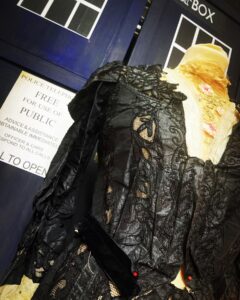
Amanda wrote in her blog:
“I have a little piece of history that lives in my loft – she was made in the late 1800s I think by a tailors called James Lindsay in the Ulster Arcade in Belfast. I believe this is mourning dress. Unfortunately, the silk facings holding the corset boning together are disintegrating rapidly but sometime soon I will try and restore her for posterity. I rescued her from a wardrobe clear out from a drama group many years ago and she had been tweaked and remade several times but she remains elegant and beautiful”.
and followed it up with a request to History Hub Ulster:
 “I wonder can anyone help me with some research pointers for this dress – it carries the label James Lindsay &Co Ulster Arcade which I believe is the Lindsay Brothers – Thomas Lindsay, Mayor of Belfast in 1875? I know they were textile merchants (and very successful too) but I don’t know if they actually produced/commissioned clothing? Any info about the company very welcome”.
“I wonder can anyone help me with some research pointers for this dress – it carries the label James Lindsay &Co Ulster Arcade which I believe is the Lindsay Brothers – Thomas Lindsay, Mayor of Belfast in 1875? I know they were textile merchants (and very successful too) but I don’t know if they actually produced/commissioned clothing? Any info about the company very welcome”.
History Hub Ulster researcher, Richard Graham takes up the story:
 James Lindsay and Co was established at 18 Donegall Place, Belfast c 1860. The Lindsay family first came to Ireland from Scotland in 1678, with their descendants moving to Belfast in 1822, opening a “woollen, linen and haberdashery warehouse” trading as J & D Lindsay on Bridge Street. The business prospered and John and David Lindsay brought into the partnership their three younger brothers, one of whom was James Lindsay after which the business at 18 Donegall Place was named.
James Lindsay and Co was established at 18 Donegall Place, Belfast c 1860. The Lindsay family first came to Ireland from Scotland in 1678, with their descendants moving to Belfast in 1822, opening a “woollen, linen and haberdashery warehouse” trading as J & D Lindsay on Bridge Street. The business prospered and John and David Lindsay brought into the partnership their three younger brothers, one of whom was James Lindsay after which the business at 18 Donegall Place was named.
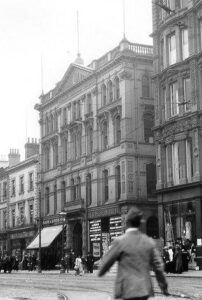 James Lindsay & Co was part of a much larger family business which traded under the name Lindsay Brothers. They first began manufacturing muslin in the early 1800s, but expanded the business to include the spinning of flax at two large mills (the Mulhouse Works and Prospect mills) and all associated processes involved in the rapidly developing linen industry. These goods were exported all over the world from their warehouse at 7-9 Donegall Place (see pic). This building still stands as the Disney Store today.
James Lindsay & Co was part of a much larger family business which traded under the name Lindsay Brothers. They first began manufacturing muslin in the early 1800s, but expanded the business to include the spinning of flax at two large mills (the Mulhouse Works and Prospect mills) and all associated processes involved in the rapidly developing linen industry. These goods were exported all over the world from their warehouse at 7-9 Donegall Place (see pic). This building still stands as the Disney Store today.
Meanwhile one of the brothers, James, developed a retail side to the business at 18 Donegall Place. The building erected in 1858, held some of the finest stock in Belfast, as can be seen by the attached advertisement of 1861. Although it had many departments, it was not a department store per sae – that concept didn’t become popular until the 1910s. It was more of a Victorian fashion emporium and traded as “The Ulster Arcade”.
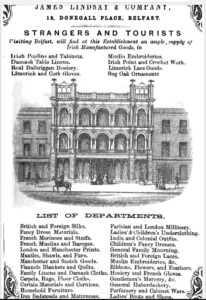 The business continued to prosper for the next 80 years, and allowed James to reside at a large house and estate called “Wheatfield” at Ballysillan, North Belfast. The business concentrated on products of Irish Manufacture, and they were soon joined by other worldwide concerns such as Robinson & Cleaver which opened their Royal Irish Linen Warehouse two doors up on Donegall Place in 1888 – the year Queen Victoria granted Belfast it’s charter as a city.
The business continued to prosper for the next 80 years, and allowed James to reside at a large house and estate called “Wheatfield” at Ballysillan, North Belfast. The business concentrated on products of Irish Manufacture, and they were soon joined by other worldwide concerns such as Robinson & Cleaver which opened their Royal Irish Linen Warehouse two doors up on Donegall Place in 1888 – the year Queen Victoria granted Belfast it’s charter as a city. 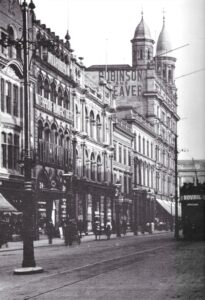 Here James Lindsay’s premises can be seen during the Edwardian period in 1910.
Here James Lindsay’s premises can be seen during the Edwardian period in 1910.
Although Lindsay Brothers were one of the largest manufacturers of linen products in Ireland – they also produced muslin, cambric and linen handkerchiefs at their Victoria Street premises which were sold at Donegall Place. My feeling is that the dress in your possession may have been imported for retail sale to the ladies of Victorian Belfast, as the range of products included fabrics and finished products from around Europe. I cannot find definitive proof that they actually commissioned or manufactured such detailed work, as the warehouse was very much focused on retail.

In 1920, James Lindsay retired to his villa in Cannes in the South of France, which was named “Lisnacrieve” after the family seat in Co Tyrone. The business was taken over by Thomas Brand, a young entrepreneur who also developed a chain of fashion stores in Belfast City Centre. Brands continued to trade as “The Ulster Arcade – successors to James Lindsay” at 18 Donegall Place until Easter 1941, when during the Blitz of Belfast by German bombers in the Second World War, the premises were completely destroyed, and the name of James Lindsay ceased to exist. Brands went on to form Brand’s Arcade (opposite) and then Brands and Normans on Castle Lane – one of the city’s leading fashion and department stores.
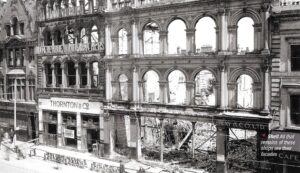
Bringing the story up to date, the site of the Ulster Arcade was later developed (in 1950) as the first branch of C&A in Northern Ireland! They were of course part of the new breed of department store (such as Littlewoods and M&S) which would take over from older stores such as James Lindsay, which dominated the market in Victoria and Edwardian times. Lindsay Brothers continued to trade until the 1960s, when with the decline of linen, they sold to Courtaulds, one of the new synthetic fibre manufacturers to arrive in NI in the 1960s.
 When the building was destroyed, Thomas Brand merged with Norman & Co on Castle Lane to form Brands & Normans. The Brand family also developed Brands Arcade (aka Birdcage Walk) becoming one of the most important fashion houses and retailers in Belfast in the “Swinging Sixties” Sadly that business has now also disappeared from the streets of Belfast, as has C&A, Robinson & Cleaver, Anderson & McAuley and all the other great stores, even up to last month when Debenhams closed down.
When the building was destroyed, Thomas Brand merged with Norman & Co on Castle Lane to form Brands & Normans. The Brand family also developed Brands Arcade (aka Birdcage Walk) becoming one of the most important fashion houses and retailers in Belfast in the “Swinging Sixties” Sadly that business has now also disappeared from the streets of Belfast, as has C&A, Robinson & Cleaver, Anderson & McAuley and all the other great stores, even up to last month when Debenhams closed down.
Article by Richard Graham, Researcher, History Hub Ulster
